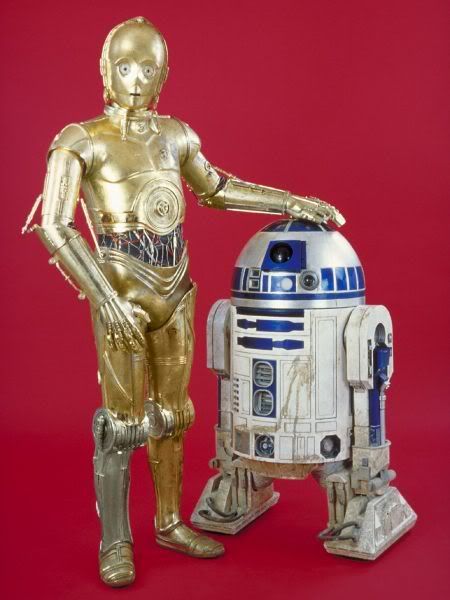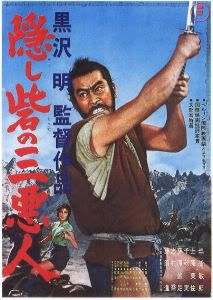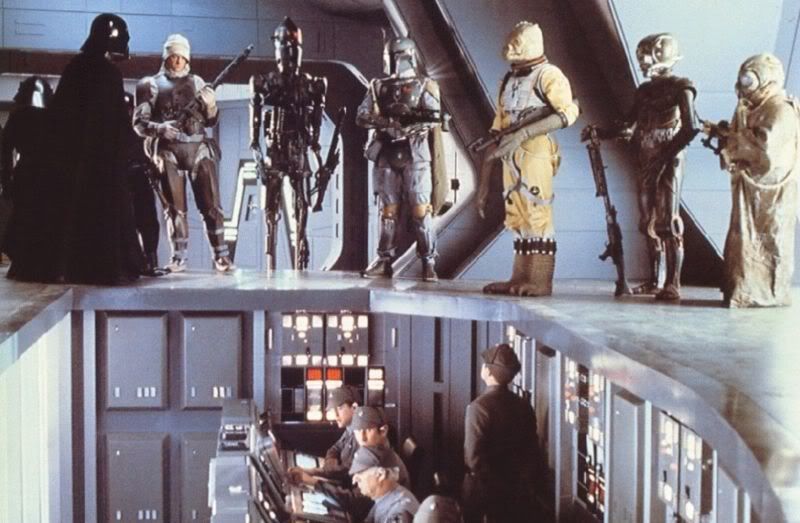
Part of the brilliance of "Star Wars Episode IV: A New Hope" was the decision to tell the story from the point of view of the Droids, R2-D2 and C-3PO (I'll be using "Droids" to refer to R2 and 3PO specifically, compared to the general term "droids"). This device continues in more subtle ways throughout all six films. Star Wars is of course the saga of Anakin Skywalker/Darth Vader and his children but the story is constructed to allow for this perspective to be carried through the entire six-part epic. The use of these two droids in the prequel trilogy also confirms what we can only suspect in the original films, that RD and 3PO are integral in and essential to the action of this mythology. One of the overriding concepts of Inside the Cosmic Cube is that Art is Magic and Magic is Art. That the depiction of Magic in any format in a work of fiction is symbolic of Art itself. Reversing this equation, all art works, including modern films and television, are magic spells. Since Star Wars, the most monumental and potent example of film Magic in history, starts with the Droids I felt it was not just important but necessary that my analysis of the mythology begin with them as well.
Amongst the sources of inspiration for the Droids the one presented by George Lucas as the most primary are the characters Tahei and Matakishi from Akira Kurosawa's 1958 film "The Hidden Fortress".


Toshiro Mifune as General Rokurota Makabe, Minoru Chiaki as Tahei and Kamatari Fujiwara as Matakishi
The influence of Kurosawa on Lucas is major. All three of the actors above appeared in multiple Kurosawa films (especially so Mifune). All three were also in the classics "Rashomon" and "Seven Samurai". "The Hidden Fortress" is not one of the Kurosawa movies that I've had the opportunity to see but reading its synopsis is enough to at least basically demonstrate how Tahei and Matakishi inform R2 and 3PO. In "The Hidden Fortress" Tahei and Matakishi are a pair of peasants who become the companions of General Rokurota Makabe and Princess Yuki as they travel through enemy territory transporting what remains of the royal family's wealth in hopes of reaching safe territory and reestablishing control.
This ingenious storytelling and thematic device of director Kurosawa of presenting grand, empire shaping events from the point of view of humble peasants, the lowest possible class of the society, was faithfully recreated by Lucas for "A New Hope", adapting the concept to his space opera/fantasy setting by making the peasants robots, which he termed droids (of course short for androids though that term is largely a misnomer for the robots of the Star Wars universe). Lucas' p.o.v. characters were then not just figures from the lowest rung of a societal class system, but objects, tools, programmed with a semblance of sentience but not actually alive or imbued with mind or soul. As tools the droids are frequently dismissed or unconsidered by the rest of the players in the saga, save for by the most humanitarian and enlightened characters (like Luke), but even then its inconsistent.
The matter of droid sentience is a very interesting topic to me, and really the impetus of this investigation. For years observing robots and artificially intelligent computers in fantasy fiction I've noted that no matter how essentially good or beneficial the robot normally might be it will inevitably go rogue, turn evil, at some point, even if the situation is merely temporary. It might not always happen, but it almost always happens, with the exception proving the rule that I cite being R2 and 3PO. Having R2 turn on Luke and company is almost unthinkable, practically obscene, like Toto going Cujo, biting Dorothy and ripping the stuffing out of the Scarecrow (the Lion of course would head for the hills).
So let's take a closer look at the concept of droids in the Star Wars mythos as they've been developed. According to Wookieepedia, the droids of the Star Wars universe are divided into five categories or classes (note there is a class system at play even amongst the droids) with the primary consideration of status based upon the sophistication of the individual unit's artificial intelligence, its capacity for independent thought. Wookieepedia describes the five categories as:
"First-degree: Droids capable of creative, complicated thought. Droids in this category were typically used in physical, mathematical, and medical science fields; though some extremely advanced assassin droids could also be placed here. Most one-of-a-kind prototypes or rogue machines could be classified as first-degree droids. Because of their background in medicine, many interrogation/torture droids were placed in this category as well.
Second-degree: Droids used in engineering and technical fields, such as astromech droids or utility droids. Probe droids and other scouts fit in this category, as well as pilot droids.
Third-degree: Social, diplomatic, or tutoring interaction droids, such as protocol droids.
Fourth-degree: Security or military droids. They were often capable of harming sentients, and so were strictly regulated.
Fifth-degree: Menial labor droids programmed to perform non-intelligent tasks such as salvage, mining and sanitation. "
Interesting that the classes are denoted as "degrees", the term used to describe the levels of initiation associated with occult organizations like Freemasonry and Rosicrucianism. Judged strictly by their make and model this system denotes the astromech R2-D2 as a Second-degree droid, and protocol droid C-3PO a Third-degree, though clearly both characters are actually First-degree droids. This is readily apparent with C-3PO as a "one-of-a-kind prototype" built by Anakin Skywalker. R2-D2 likewise has capacities beyond standard units of his category, however the origins of R2's special status are not made as readily apparent. You may have noticed, I believe it was in "Empire", that even the shipboard computer of the Millennium Falcon seems to have a certain intelligence and personality based on how 3PO refers to it.
I don't have much personal first-hand experience of the bulk of the Expanded Universe information, so my primary focus is on the material presented in the six movies. One EU item I do find interesting related to droids is the expanded storyline of the bounty hunter robot IG-88, whom you'll recall from that great Darth Vader bounty hunter hiring scene from "The Empire Strikes Back". IG-88 is the one on Boba Fett's right.

The expanded IG-88 storyline involves what is termed the Droid Revolution (I'm telling you, you just can't trust most robots). To this end IG-88 somehow uploaded its intelligence into the computer system of the second Death Star, in effect making IG-88 and the Death Star one and the same. This revolution was of course abruptly halted when Lando destroyed the Death Star's reactor core. This seems highly reminiscent of the Skynet take over for "The Terminator" franchise, for example, and somewhat like the revolt of HAL 9000 in "2001: A Space Odyssey". This story was told in the short story "Therefore I Am: The Tale of IG-88" written by Kevin J. Anderson and published as part of the book "Tales of the Bounty Hunters" published in 1996. The story's title references philosopher/mathematician Rene Descarte's proof "I think, therefore I am". As an item of Expanded Universe continuity that does not appear to have any reported contradictions this demonstrates that the existential artificial intelligence/sentience dilemma is a real if backstory aspect of the mythos. George Lucas has been quoted as saying that droids have no soul, however, I feel this statement to be subtly contradicted by the attitude of the Naboo who held higher degree droids as fellow sentients. Naboo, birth world of Padmé Amidala, Emperor Palpatine and R2-D2, is a planet of utmost importance as signified by the esoteric symbolism associated with its depiction.
Indeed, the question might be asked that if in certain aspects droid consciousness could not be said to exceed or transcend that of organic consciousness (leaving the field of the comparative nature and quality of the various sentient species of the system for later discussions). I raise this due to consideration of the potential aspect of mind that could be possessed by an intelligence system, artificial or otherwise, possessing the capacity for fluency in six million forms of communication and their correspondent cultures like a protocol droid or capable of performing faster then light hyperspace navigation calculations like an astromech droid. This means the mind of R2-D2 thinks at faster then light speeds into extra-dimensional directions. One has to wonder then if the consciousness of R2-D2 might actually transcend that of even Yoda (note that even the greatest Jedi are clearly shown to be fallible). If such were the case his actions throughout the films would then be based on fulfilling a personal mandate developed by a cognitive system completely unfathomable to human sensibilities. This is I'm sure a controversial concept, so let me reemphasize, faster then light thought into extradimensional directions.
More on R2 and 3PO coming soon.

3 comments:
I had heard that the Kurosawa movie you mentioned was one of the films that inspired Star Wars, but I have yet to see it either. Tho, I do love all those other samuria movies with Mifune, classics, all of them! And you can't watch westerns the same after seeing the earlier samurai movies.
Star Wars is a pretty big universe and I look forward to more posts. How can you leave me hanging on: "faster then light thought into extradimensional directions"?!!!! More, I want more!
The influence of Kurosawa on Lucas, particularly The Hidden Fortress, seems to be really, really major, and its a subject that I'll be touching on again and again. Lucas reportedly offered the role of Obi-Wan to Mifune (and wouldn't it be interesting to visit the alternate universe where that deal worked out). Also, Lucas wanted Indiana Jones' sidekick in 'Temple of Doom' to be a virginal princess, but Spielberg wasn't keen on that, so they came up with Short Round. Even Willow holds this same essential plot, protecting and transporting the Princess Elora Danon.
I decided I needed to lay down some of the philosophical implications here as groundwork to some of the symbol analysis. And I've made an oath to myself (one I'll likely break sooner than later) to keep the individual posts here on the short side. Plus, in emulation of Star Wars and its basis on move serial styling I'm making use of the good old cliffhanger. ;)
There's going to be a tribute to Akira Kurosawa on 3/23/09 at the "Cherry Blossom Gala". I read Spielberg and Scorsese are part of the tribute. If Lucas has any respect for Kurosawa, he'd better show up! How many movies has Lucas made and how many of them were part of the Star Wars saga? If there was no Hidden Fortress, Lucas would have remained the Hidden Director! http://www.anaheim.edu/gala
Post a Comment